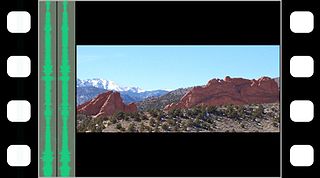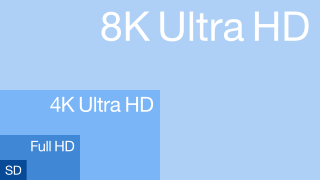
Letter-boxing is the practice of transferring film shot in a widescreen aspect ratio to standard-width video formats while preserving the film's original aspect ratio. The resulting video-graphic image has mattes empty space above and below it; these mattes are part of each frame of the video signal.

Pan and scan is a method of adjusting widescreen film images so that they can be shown in fullscreen proportions of a standard-definition 4:3 aspect ratio television screen, often cropping off the sides of the original widescreen image to focus on the composition's most important aspects.

Video is an electronic medium for the recording, copying, playback, broadcasting, and display of moving visual media. Video was first developed for mechanical television systems, which were quickly replaced by cathode-ray tube (CRT) systems, which, in turn, were replaced by flat-panel displays of several types.

VistaVision is a higher resolution, widescreen variant of the 35 mm motion picture film format that was created by engineers at Paramount Pictures in 1954.

70 mm film is a wide high-resolution film gauge for motion picture photography, with a negative area nearly 3.5 times as large as the standard 35 mm motion picture film format. As used in cameras, the film is 65 mm (2.6 in) wide. For projection, the original 65 mm film is printed on 70 mm (2.8 in) film. The additional 5 mm contains the four magnetic stripes, holding six tracks of stereophonic sound. Although later 70 mm prints use digital sound encoding, the vast majority of existing and surviving 70 mm prints pre-date this technology.

IMAX is a proprietary system of high-resolution cameras, film formats, film projectors, and theaters known for having very large screens with a tall aspect ratio and steep stadium seating, with the 1.43:1 ratio format being available only in few selected locations.
Anamorphic widescreen is a process by which a comparatively wide widescreen image is horizontally compressed to fit into a storage medium with a narrower aspect ratio, reducing the horizontal resolution of the image while keeping its full original vertical resolution. Compatible play-back equipment can then expand the horizontal dimension to show the original widescreen image. This is typically used to allow one to store widescreen images on a medium that was originally intended for a narrower ratio, while using as much of the frame – and therefore recording as much detail – as possible.
Negative pulldown is the manner in which an image is exposed on a film stock, described by the number of film perforations spanned by an individual frame. It can also describe whether the image captured on the negative is oriented horizontally or vertically. Changing the number of exposed perforations allows a cinematographer to change both the aspect ratio of the image and the size of the area on the film stock that the image occupies.
High-definition video is video of higher resolution and quality than standard-definition. While there is no standardized meaning for high-definition, generally any video image with considerably more than 480 vertical scan lines or 576 vertical lines (Europe) is considered high-definition. 480 scan lines is generally the minimum even though the majority of systems greatly exceed that. Images of standard resolution captured at rates faster than normal, by a high-speed camera may be considered high-definition in some contexts. Some television series shot on high-definition video are made to look as if they have been shot on film, a technique which is often known as filmizing.

The pillarbox effect occurs in widescreen video displays when black bars are placed on the sides of the image. It becomes necessary when film or video that was not originally designed for widescreen is shown on a widescreen display, or a narrower widescreen image is displayed within a wider aspect ratio, such as a 16:9 image in a 2.39:1 frame. The original material is shrunk and placed in the middle of the widescreen frame.

Anamorphic format is the cinematography technique of shooting a widescreen picture on standard 35 mm film or other visual recording media with a non-widescreen native aspect ratio. It also refers to the projection format in which a distorted image is "stretched" by an anamorphic projection lens to recreate the original aspect ratio on the viewing screen. The word anamorphic and its derivatives stem from the Greek anamorphoo, compound of morphé with the prefix aná. In the late 1990s and 2000s, anamorphic lost popularity in comparison to "flat" formats such as Super 35 with the advent of digital intermediates; however, in the years since digital cinema cameras and projectors have become commonplace, anamorphic has experienced a considerable resurgence of popularity, due in large part to the higher base ISO sensitivity of digital sensors, which facilitates shooting at smaller apertures.

The technology of television has evolved since its early days using a mechanical system invented by Paul Gottlieb Nipkow in 1884. Every television system works on the scanning principle first implemented in the rotating disk scanner of Nipkow. This turns a two-dimensional image into a time series of signals that represent the brightness and color of each resolvable element of the picture. By repeating a two-dimensional image quickly enough, the impression of motion can be transmitted as well. For the receiving apparatus to reconstruct the image, synchronization information is included in the signal to allow proper placement of each line within the image and to identify when a complete image has been transmitted and a new image is to follow.
"21:9" is a consumer electronics (CE) marketing term to describe the ultrawide aspect ratio of 64:27, designed to show films recorded in CinemaScope and equivalent modern anamorphic formats. The main benefit of this screen aspect ratio is a constant display height when displaying other content with a lesser aspect ratio.

4K resolution refers to a horizontal display resolution of approximately 4,000 pixels. Digital television and digital cinematography commonly use several different 4K resolutions. In television and consumer media, 3840 × 2160 is the dominant 4K standard, whereas the movie projection industry uses 4096 × 2160.

8K resolution refers to an image or display resolution with a width of approximately 8,000 pixels. 8K UHD is the highest resolution defined in the Rec. 2020 (UHDTV) standard.
The aspect ratio of an image is the ratio of its width to its height, and is expressed with two numbers separated by a colon, such as 2.40:1. For the 2.40:1 aspect ratio, the image is 2.40:1 units wide and 2.40:1 units high. Common aspect ratios are 1.85:1 and 2.40:1 in cinematography, 4:3 and 16:9 in television photography, and 3:2 in still photography. The film was filmed in 2.40:1 widescreen.

Grabyo is a browser-based live video production suite integrated with other social media platforms such as Facebook, YouTube, Instagram, Snapchat, Twitter, and Periscope. Sports federations and media companies use cloud-based technology to produce professional-quality live streams and video clips for digital audiences.

16K resolution is a display resolution with approximately 16,000 pixels horizontally. The most commonly discussed 16K resolution is 15360 × 8640, which doubles the pixel count of 8K UHD in each dimension, for a total of four times as many pixels. This resolution has 132.7 megapixels, 16 times as many pixels as 4K resolution and 64 times as many pixels as 1080p resolution.

The Vertical Film Festival (VFF) is a film festival held in Katoomba, New South Wales, Australia. Established in 2014, the Festival was conceived to encourage exploration of vertical film and video. This nascent format is variously referred to as tall-screen, portrait format, 9:16 aspect ratio or simply vertical video for short. The VFF was the first worldwide competition to be held for vertical videos and has since become a biennial event with public screenings in suitably vertical venues.















